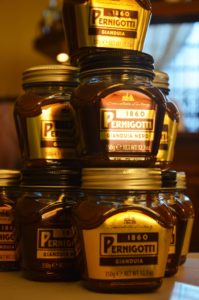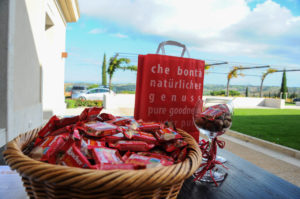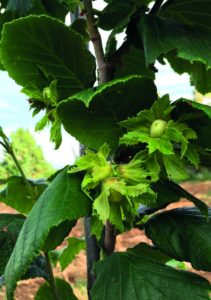 A valuable resource. Hazelnut is one of the main raw materials for the realization of many confectionery products. For this reason there is strong demand for this product by industry. In Italy, the second largest world producer with 14% share behind Turkey, hazelnut tree is grown intensively in a few areas: Piedmont, Lazio, Campania, and Sicily. A production in 2016 of 130,000 tonnes on about 68,600 hectares is estimated, and by 2022 conversion of 20,000 hectares is expected, for + 30% area and + 40% volume. Performance concerning production yields, too, improved. This is the result of a tested and efficient supply chain, able to guarantee high quality standards as for both hazelnuts for industry (about 70% of production), and for fresh consumption.
A valuable resource. Hazelnut is one of the main raw materials for the realization of many confectionery products. For this reason there is strong demand for this product by industry. In Italy, the second largest world producer with 14% share behind Turkey, hazelnut tree is grown intensively in a few areas: Piedmont, Lazio, Campania, and Sicily. A production in 2016 of 130,000 tonnes on about 68,600 hectares is estimated, and by 2022 conversion of 20,000 hectares is expected, for + 30% area and + 40% volume. Performance concerning production yields, too, improved. This is the result of a tested and efficient supply chain, able to guarantee high quality standards as for both hazelnuts for industry (about 70% of production), and for fresh consumption.
The variety of hazelnut grown in Piedmont is Trefoil ‘Tonda Gentile (Round Delicate)’, whose prices for PGI version reach 9.30 Euros per kg for industrial use. Its production is concentrated in the provinces of Cuneo, Asti and Alessandria. Currently, the province of Cuneo holds in Piedmont the record of area cultivated for hazelnut production, with approximately 7,000 hectares. These surfaces are gradually increasing, driven by an increasing number of producers who are converting their production.
 Hazelnut has important economic potential, with a value that can reach 400-500 Euros per quintal of harvested product; it is much higher than other agricultural crops. Piedmont hazelnut is particularly appreciated by the confectionery industry for its quality parameters. Today, the regional production is close to 150,000 tonnes, accounting for about 8-9% of national production (data: Piedmont Hazelnut Consortium). The real problem is that the Italian hazelnut production cannot cover all industrial needs. Alessandro Sandiano, marketing director of Pernigotti, highlights: ‘We use on a massive scale Italian hazelnuts, and those coming from Piedmont in particular. However, this is only a part of the industrial needs. For this reason, as the whole confectionery industry that uses hazelnut cream as basic product does, we are obliged to look for other sources of supply, too. This is the case, for example, of Turkish hazelnuts, of which there is good availability. These hazelnuts, of course, must meet rigorous quality criteria before being included in our production processes’. On average, each year Pernigotti processes 1 million and 300 thousand kg of chocolate and 710 thousand kg of hazelnuts that come from both Turkey and Italy.
Hazelnut has important economic potential, with a value that can reach 400-500 Euros per quintal of harvested product; it is much higher than other agricultural crops. Piedmont hazelnut is particularly appreciated by the confectionery industry for its quality parameters. Today, the regional production is close to 150,000 tonnes, accounting for about 8-9% of national production (data: Piedmont Hazelnut Consortium). The real problem is that the Italian hazelnut production cannot cover all industrial needs. Alessandro Sandiano, marketing director of Pernigotti, highlights: ‘We use on a massive scale Italian hazelnuts, and those coming from Piedmont in particular. However, this is only a part of the industrial needs. For this reason, as the whole confectionery industry that uses hazelnut cream as basic product does, we are obliged to look for other sources of supply, too. This is the case, for example, of Turkish hazelnuts, of which there is good availability. These hazelnuts, of course, must meet rigorous quality criteria before being included in our production processes’. On average, each year Pernigotti processes 1 million and 300 thousand kg of chocolate and 710 thousand kg of hazelnuts that come from both Turkey and Italy.
 On the centenary of its birth, in 2025, Loacker will need 3,500 tonnes of hazelnuts (equivalent to 7,800 tonnes of product in shell) in order to produce its famous and appreciated wafers. So, in order to be self-sufficient and guarantee to its consumers the use of a fundamental raw material and entirely Italian, the Company has put in place ‘Hazelnuts in Tuscany’ project for sustainable production of these fruits, thanks to the collaboration initiated with farmers in this region. This is ambitious project, dictated by the need to avoid being subject to a market dominated, as regards market prices, by Turkey, with 70% hazelnuts produced in the world. The new area chosen by Loacker for the cultivation is in Maremma in Grosseto province, where the project was started in 2011 and where, since 2014, 25,300 plants have been planted (the first 50 hectares) in Corte Migliorina farm (municipality of Orbetello, location Fonteblanda locality). Six million Euros were invested in 2012 for preparation of the soil, purchase, and planting of plants, for a cutting-edge facility in the name of water saving as well as technical and housing infrastructure. 6 million Euros are further expected in 2017-2018 biennium for cultivation in Tuscany.
On the centenary of its birth, in 2025, Loacker will need 3,500 tonnes of hazelnuts (equivalent to 7,800 tonnes of product in shell) in order to produce its famous and appreciated wafers. So, in order to be self-sufficient and guarantee to its consumers the use of a fundamental raw material and entirely Italian, the Company has put in place ‘Hazelnuts in Tuscany’ project for sustainable production of these fruits, thanks to the collaboration initiated with farmers in this region. This is ambitious project, dictated by the need to avoid being subject to a market dominated, as regards market prices, by Turkey, with 70% hazelnuts produced in the world. The new area chosen by Loacker for the cultivation is in Maremma in Grosseto province, where the project was started in 2011 and where, since 2014, 25,300 plants have been planted (the first 50 hectares) in Corte Migliorina farm (municipality of Orbetello, location Fonteblanda locality). Six million Euros were invested in 2012 for preparation of the soil, purchase, and planting of plants, for a cutting-edge facility in the name of water saving as well as technical and housing infrastructure. 6 million Euros are further expected in 2017-2018 biennium for cultivation in Tuscany.
